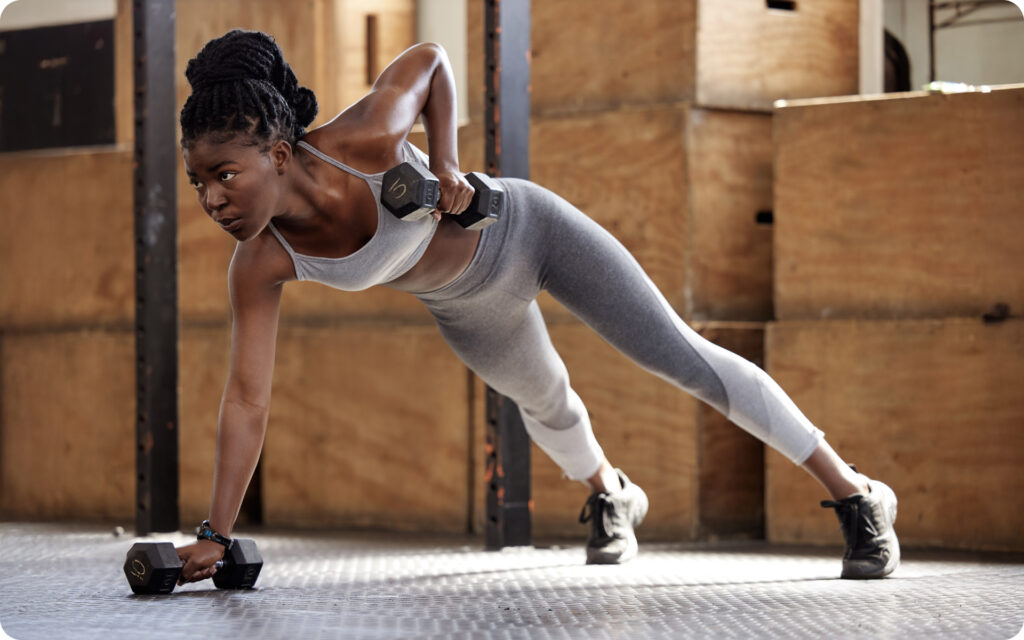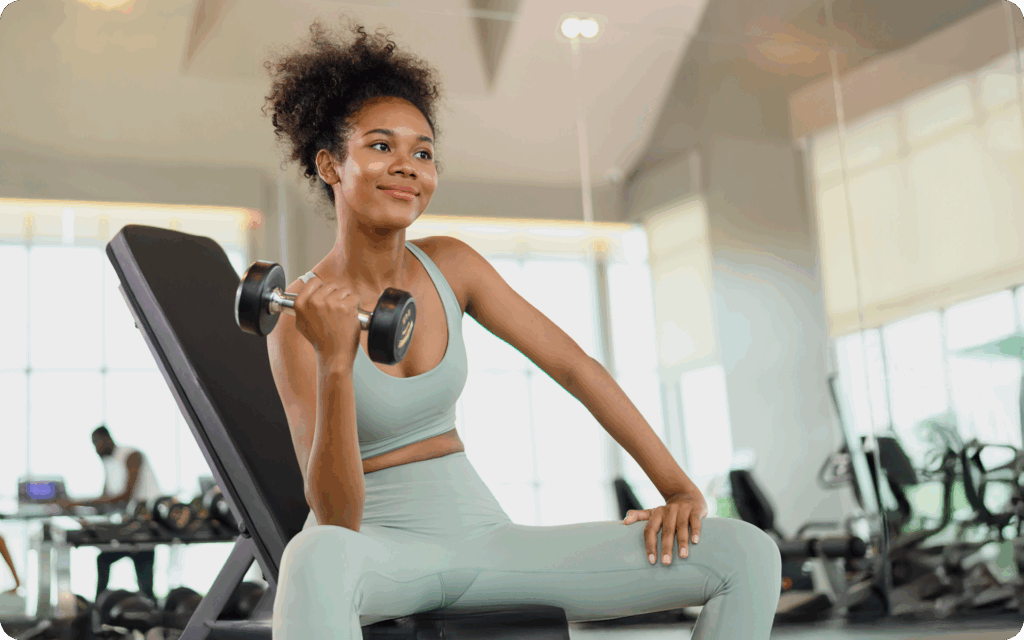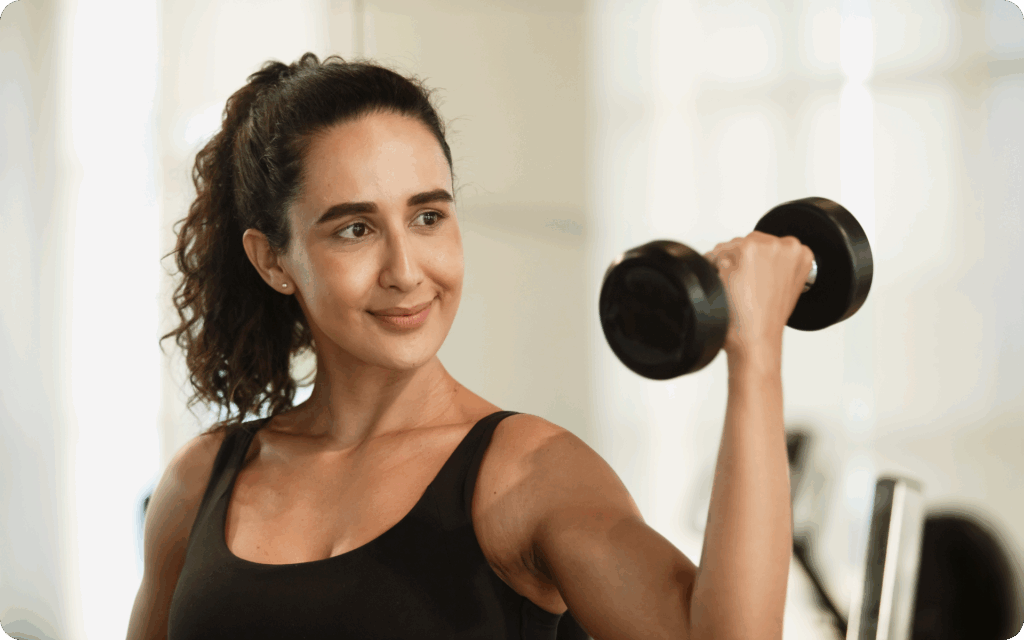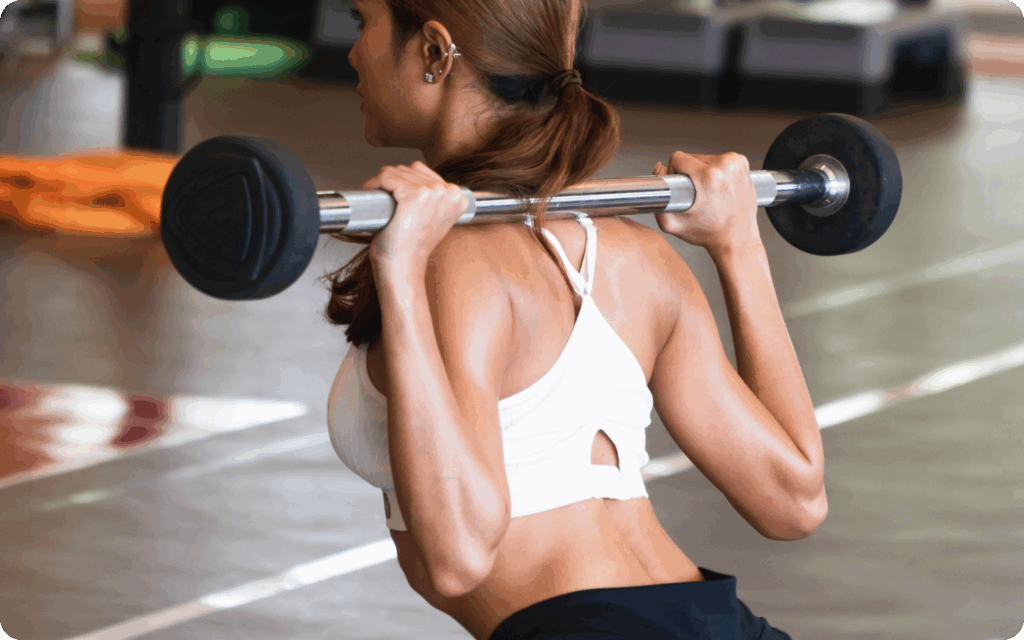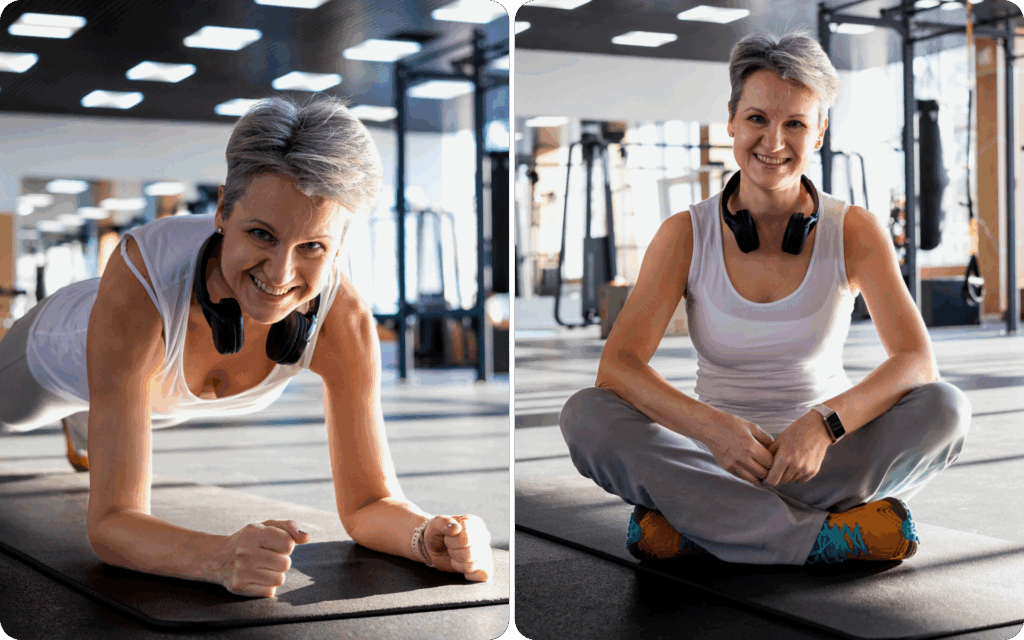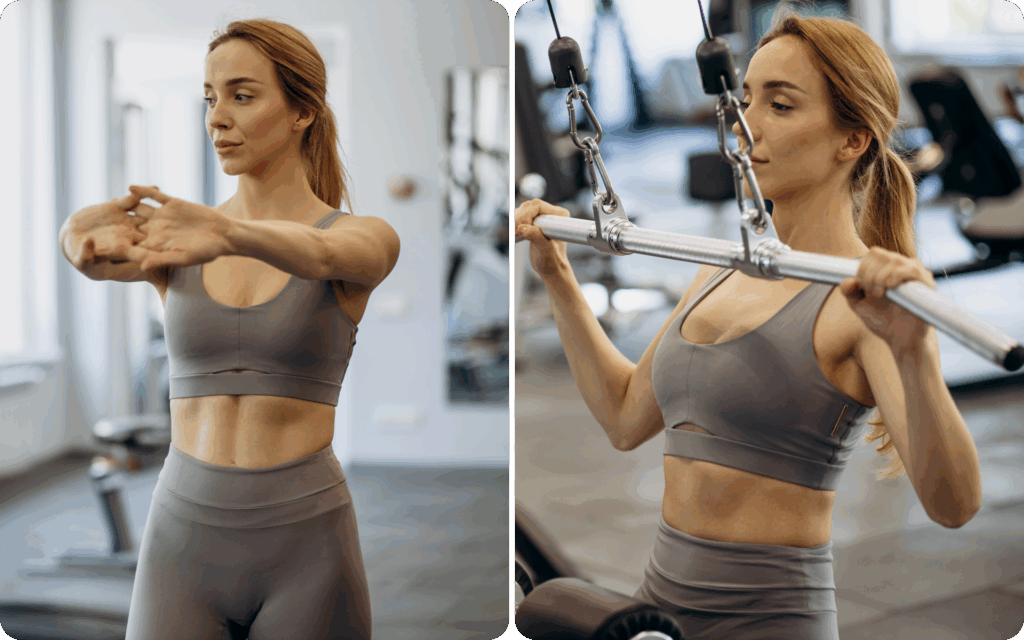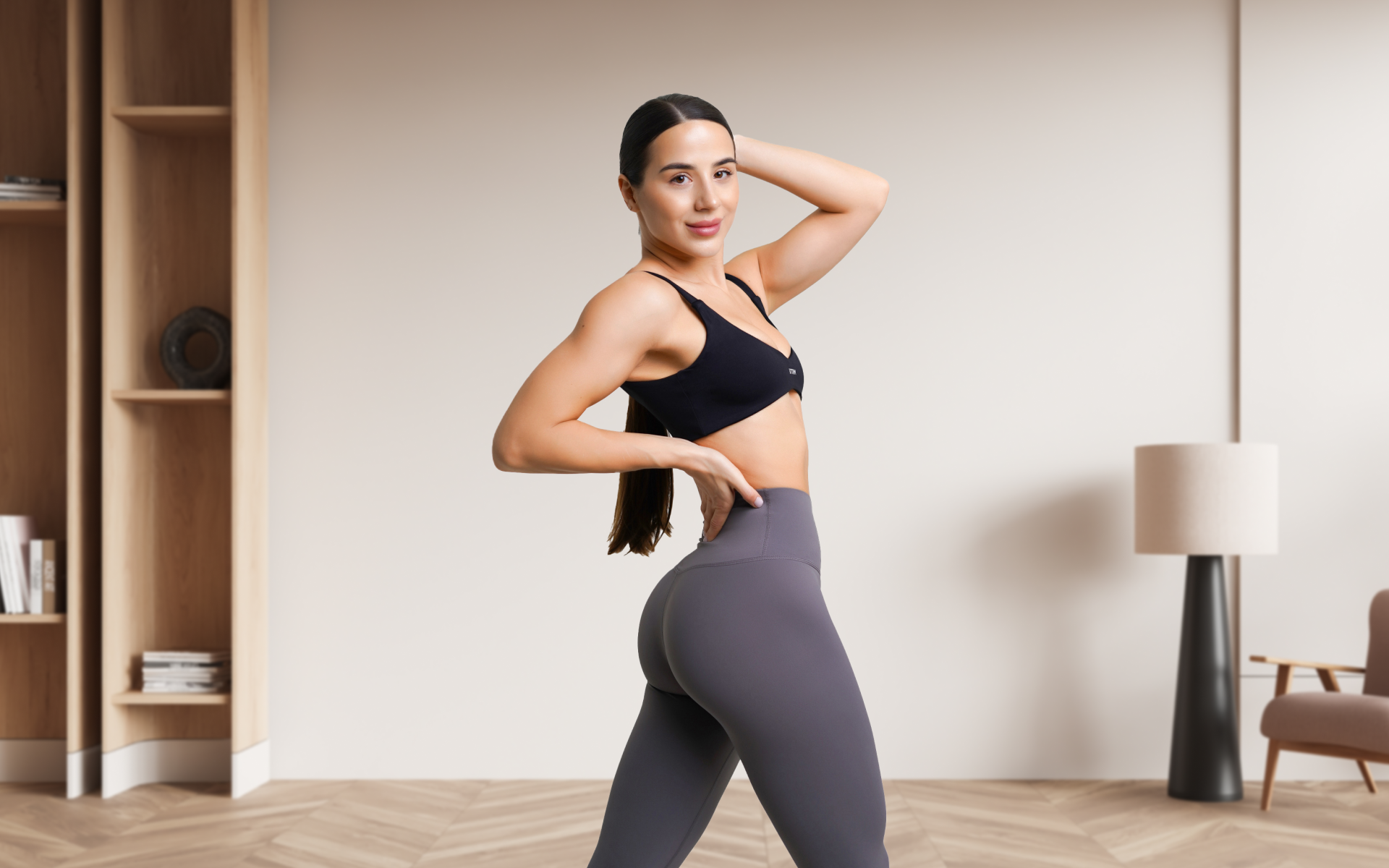Committing to a new fitness goal can feel like a significant undertaking, but a structured plan makes the process clear and achievable. An eight-week timeframe is substantial enough to produce noticeable changes in body composition, strength, and overall well-being.
This guide provides an evidence-based, structured approach to help you maximize your efforts over the next two months.
We’ll move beyond generic advice and focus on what recent scientific studies show is most effective for female fat loss. This involves a strategic combination of resistance training and high-intensity work, all laid out in a clear, week-by-week format. You’ll learn not just what to do, but why it works, empowering you to take control of your fitness journey.
Can You Get in Shape in 8 Weeks?
Yes, you can make significant progress in getting in shape in eight weeks (1). While a complete transformation will depend on your starting point and consistency, this period is ideal for establishing powerful habits and achieving measurable results. The key is to adhere to a well-designed program that prioritizes effective training methods.
In two months, you can expect to see improvements in several areas. These include increased strength, better muscular definition, reduced body fat, and enhanced cardiovascular endurance (1).
An effective plan will focus on changing your body composition – increasing lean muscle while decreasing fat mass – rather than just losing weight on the scale. This is a more sustainable and healthier approach for an 8-week transformation for females (2).
How to Lose Belly Fat in 8 Weeks
Losing belly fat, or more specifically visceral fat (the fat surrounding your organs), requires a comprehensive strategy. It isn’t possible to “spot reduce” fat from one specific area of your body through targeted exercises like crunches. Fat loss occurs systemically, which means that you lose it from all over your body as a result of a consistent calorie deficit (3).
You need a combination of nutrition and exercise to achieve this deficit. A modest calorie deficit of 15-25% below your maintenance level is a sustainable target (4). This should be paired with a protein intake of approximately 1.6 to 2.2 grams per kilogram of body weight daily to help preserve muscle mass while you lose fat (5).
From an exercise standpoint, research has consistently shown that a combination of resistance training and high-intensity interval training (HIIT) is highly effective (6). This dual approach helps maximize calorie expenditure during and after workouts while building muscle, which boosts your resting metabolic rate.
To learn more about exercises that support this goal, check out our guide on the best exercises to lose belly fat female.
BetterMe: Health Coaching app helps you achieve your body goals with ease and efficiency by helping to choose proper meal plans and effective workouts. Start using our app and you will see good results in a short time.
What Exercise Burns the Most Belly Fat?
No single exercise burns belly fat exclusively. However, certain types of exercise are more effective for promoting overall fat loss, which includes abdominal fat. Compound resistance exercises and high-intensity interval training (HIIT) are the two most powerful tools for this purpose (6).
Compound movements such as squats, deadlifts, and overhead presses engage multiple muscle groups simultaneously. This high level of muscle activation demands more energy, which leads to a greater calorie burn compared to isolation exercises (7). More importantly, it stimulates muscle growth, which increases your metabolism in the long term (8).
HIIT involves short bursts of intense, near-maximum effort followed by brief recovery periods. Studies have shown that HIIT is particularly effective for reducing abdominal and visceral fat, often in less time than traditional steady-state cardio (9). A protocol might involve 30-60 seconds of all-out effort on a bike or rower, followed by 60-180 seconds of easy recovery, repeated for several rounds.
What Is a Fat-Burning 8-Week Workout Plan for Females?
A fat-burning 8-week transformation female workout program is one that methodically integrates the most effective training principles for improving body composition. It’s not a random collection of workouts, but a structured plan that is built on progressive overload. The primary goal is to lose fat while preserving, or even building, lean muscle mass.
This plan is centered around three days of resistance training (RT) per week. These sessions are the foundation for building strength and muscle. This is complemented by two shorter, high-intensity interval training (HIIT) sessions that are designed to maximize fat oxidation and improve cardiovascular health efficiently.
The program is structured to ensure you are consistently challenging your body. Over the eight weeks, you’ll gradually increase the demands placed on your muscles by lifting slightly heavier weights or performing more repetitions. This forces your body to adapt and grow stronger, which is the cornerstone of a successful transformation (10).
Read more: Does Lifting Weights Support Healthy Blood Sugar Levels?
What Is the Best Workout Split to Lose Belly Fat?
The “best” workout split is the one you can adhere to consistently. However, for fat loss, some splits are more efficient than others. A full-body routine or an upper/lower split are excellent choices as they ensure major muscle groups are trained frequently, which maximizes your weekly calorie expenditure and muscle stimulus.
A typical and highly effective split for this 8-week workout plan for females with weights is:
- Day 1: Lower-body strength
- Day 2: Upper-body strength
- Day 3: HIIT and core
- Day 4: Active recovery
- Day 5: Full-body metabolic conditioning
- Days 6: HIIT
- Day 7: Active recovery or rest
This structure allows you to hit all major muscle groups twice a week with resistance, which is optimal for muscle preservation and growth. The dedicated HIIT days provide a powerful metabolic boost without interfering with recovery from your heavy lifting sessions. Recent research has indicated that as long as total weekly training volume is matched, training frequency can be flexible (11), so you can adapt this to fit your schedule.
If you prefer to train at home with minimal equipment, you might find our 8-week calisthenics program a great alternative.
Read more: Strength Training Workout Plan for Women: Exercises, Tips, and FAQs
How Much Weight Can You Lose in 8 Weeks as a Female?
A safe, sustainable, and realistic rate of weight loss is 0.5% to 1% of your body weight per week (12). For a 150-pound woman, this equates to 0.75 to 1.5 pounds per week. Over eight weeks, this would result in a total weight loss of approximately 6 to 12 pounds.
It’s important to focus on fat loss rather than just weight loss. The scale doesn’t differentiate between fat, muscle, and water. A program that prioritizes resistance training and adequate protein intake will help ensure that the majority of the weight you lose is from fat (13), not precious muscle tissue.
Tracking progress with photos and body measurements (like waist, hips, and thighs) often tells a more accurate story than the scale alone. You might see your body shape change dramatically even if the number on the scale moves slowly. This is a sign of a successful 8-week transformation female program.
Program Notes
Before you begin this 2-month workout plan for females, familiarize yourself with the key concepts, equipment, and structure.
Terms:
- Resistance Training (RT): Exercise that causes muscles to contract against an external resistance, such as weights, bands, or your own body weight.
- High-Intensity Interval Training (HIIT): A training protocol that involves short periods of intense anaerobic exercise with less-intense recovery periods.
- Rate of Perceived Exertion (RPE): A scale from 1 to 10 that is used to measure the intensity of your effort. An RPE of 7-8 means the exercise feels challenging, and you could only do 2-3 more reps with good form.
- Compound Exercise: A multi-joint movement that works several muscle groups at once (e.g. squats, deadlifts).
- Progressive Overload: The principle of gradually increasing the demands on your body over time to drive adaptation (e.g, adding weight, reps, or sets).
- Deload: A planned period of reduced training intensity or volume to allow for recovery and prevent overtraining.
Required Equipment
- Dumbbells (a few different weights)
- Barbell with weight plates
- Squat rack
- Bench
- Pull-up bar or lat pulldown machine
- Resistance bands
- Stationary bike, rower, or treadmill for HIIT
Training Split and Schedule
This plan follows a 5-day training week with 2 rest or active recovery days.
- Day 1: Lower-body strength
- Day 2: Upper-body strength
- Day 3: HIIT and core
- Day 4: Active recovery
- Day 5: HIIT
- Days 6 and 7: Active recovery or rest
Sets, Reps, and Rest
- Strength Days (Days 1 and 2): Aim for 3-4 sets of 6-12 reps. Rest for 60-120 seconds between sets. For heavy compound lifts in the 6-8 rep range, you may need closer to 120 seconds.
- Full-Body Day (Day 5): Use slightly lighter weights for 3-4 sets of 10-15 reps. Keep rest periods shorter, around 45-60 seconds, to increase the metabolic demand.
- HIIT Days (Days 3 and 6): Follow the specific work-to-rest ratios provided in the plan.
- Progression: Every week or two, aim to increase the weight by 2.5-5% or add 1-2 reps to each set while maintaining good form and the target RPE.
- Deload: After week 4, perform a deload week. Reduce the number of sets you perform by 30-40% or reduce your working weights to an RPE of 6 (feels light with several reps left in the tank).
Menstrual Cycle Considerations
Hormonal fluctuations can affect energy levels and performance (14). Use this as a guide, but always listen to your body.
- Follicular Phase (Weeks 1-2, post-period): Estrogen is rising. You may feel stronger and have more energy. This is a great time to push for progressive overload with heavier lifts.
- Luteal Phase (Weeks 3-4, pre-period): Progesterone is dominant. You might feel more fatigued or experience PMS symptoms. It may be a good time to focus on technique, use slightly lighter loads, or prioritize recovery. Don’t stop training, but adjust intensity as needed.
Whether you’re a workout beast or just a beginner making your first foray into the world of fitness and dieting – BetterMe has a lot to offer to both newbies and experts! Install the app and experience the versatility first-hand!
The 8-Week Workout Plan
Here’s the detailed weekly schedule. Perform the exercises in the order listed.
Weeks 1-4
Day 1: Lower Body
- Barbell back squat: 4 sets of 6-8 reps (RPE 8)
- Romanian deadlift (RDL): 3 sets of 8-10 reps (RPE 7)
- Dumbbell walking lunge: 3 sets of 10-12 reps per leg (RPE 8)
- Glute bridge or hip thrust: 3 sets of 10-12 reps (RPE 8)
- Standing calf raise: 3 sets of 15-20 reps (RPE 9)
Day 2: Upper Body
- Dumbbell bench press: 4 sets of 8-10 reps (RPE 8)
- Pull-up or lat pulldown: 3 sets of 8-10 reps (or as many as possible if bodyweight) (RPE 8)
- Dumbbell shoulder press: 3 sets of 8-10 reps (RPE 8)
- Bent-over dumbbell row: 3 sets of 10-12 reps per arm (RPE 7)
- Face pull: 3 sets of 15-20 reps (RPE 8)
Day 3: HIIT and Core
- HIIT (15 mins): Choose a bike, rower, or treadmill.
- Warm-up: 5 minutes of easy pedaling/jogging.
- Intervals: 8 rounds of 30 seconds max effort (RPE 9-10) followed by 60 seconds of very easy recovery.
- Cool-down: A few minutes of easy pedaling/walking to get your heart rate down again.
- Core Circuit (3 rounds):
- Plank: 45-60 seconds
- Hanging knee raise: 10-15 reps
- Bird-dog: 10 reps per side
- Rest 60 seconds between rounds.
Day 4: Active Recovery
30-45 minutes of low-intensity activity such as walking, stretching, or foam rolling.
Day 5: Full Body
- Goblet squat: 3 sets of 12-15 reps (RPE 7)
- Push-up (on knees or toes): 3 sets to failure (RPE 9)
- Dumbbell single-arm row: 3 sets of 12-15 reps per arm (RPE 7)
- Dumbbell step-up: 3 sets of 10-12 reps per leg (RPE 8)
- Plank with shoulder tap: 3 sets of 20-30 total taps (RPE 8)
Day 6: HIIT
- HIIT (21 mins): Choose a bike, rower, or treadmill.
- Warm-up: 5 minutes of easy pedaling/jogging.
- Intervals: 8 rounds of 60 seconds hard effort (RPE 8) followed by 60 seconds of easy recovery.
- Cool-down: A few minutes of easy pedaling/walking to get your heart rate down again.
Day 7: Rest
Week 4 is a deload week. Reduce sets by 1 per exercise or use lighter weights (RPE 6).
Weeks 5-8
Day 1: Lower Body
- Barbell back squat: 4 sets of 8-10 reps (RPE 8)
- Good morning: 3 sets of 10-12 reps (RPE 7)
- Bulgarian split squat: 3 sets of 8-10 reps per leg (RPE 8)
- Hip thrust with hold: 3 sets of 8-10 reps (2-second pause at top) (RPE 8)
- Seated calf raise: 3 sets of 12-15 reps (RPE 9)
Day 2: Upper Body
- Incline dumbbell press: 4 sets of 8-10 reps (RPE 8)
- Pull-up or lat pulldown: 4 sets of 6-8 reps (or as many as possible) (RPE 8)
- Arnold press: 3 sets of 10-12 reps (RPE 8)
- Chest-supported row: 3 sets of 10-12 reps (RPE 7)
- Lateral raise: 3 sets of 12-15 reps (RPE 9)
Day 3: HIIT and Core
- HIIT (20 mins): Choose a bike, rower, or treadmill.
- Warm-up: 5 minutes of easy pedaling/jogging.
- Intervals: 10 rounds of 30 seconds max effort (RPE 9-10) followed by 60 seconds of very easy recovery.
- Cool-down: 5 minutes of easy pedaling/walking.
- Core Circuit (3 rounds):
- Side plank: 30-45 seconds per side
- Leg lower: 12-15 reps
- Pallof press: 10 reps per side
- Rest 60 seconds between rounds.
Day 4: Active Recovery
30-45 minutes of low-intensity activity.
Day 5: Full Body
- Dumbbell front squat: 3 sets of 10-12 reps (RPE 8)
- Inverted row: 3 sets to failure (RPE 9)
- Dumbbell Romanian deadlift: 3 sets of 12-15 reps (RPE 7)
- Dumbbell renegade row: 3 sets of 8-10 reps per arm (RPE 8)
- Bear crawl: 3 sets of 45-60 seconds (RPE 8)
Day 6: HIIT
- HIIT (25 mins): Choose a bike, rower, or treadmill.
- Warm-up: 5 minutes of easy pedaling/jogging.
- Intervals: 10 rounds of 60 seconds hard effort (RPE 8) followed by 60 seconds of easy recovery.
- Cool-down: 5 minutes of easy pedaling/walking.
Day 7: Rest
For more guidance on structuring your weekly routine, see our sample workout schedule for beginners female.
It’s possible for some individuals, but it will be heavily dependent on your starting body fat percentage and genetics. Visible abs require a very low body fat level (typically below 20% for women, but even then, genetics may prevent them from becoming visible) (15). For most people, 8 weeks is enough time to significantly reduce belly fat and strengthen the core, but achieving “visible abs” may take longer. Fat loss location is primarily determined by genetics (16). Most people tend to lose fat first from areas where they store it last. Common areas for initial fat loss in women include the face, arms, and chest, while areas such as the hips, thighs, and lower abdomen are often the last to lean out. You should focus on both through the principle of progressive overload. In your strength-focused sessions (6-12 rep range) (17), the primary goal is to gradually increase the weight (load) you’re lifting. In your metabolic sessions (10-15+ rep range) (17), you might focus more on increasing the number of reps you can perform with a consistent weight. Both are valid ways to progress. For fat loss and muscle preservation, it is almost always better to perform resistance training before cardio. Lifting weights requires maximum strength and focus. Doing cardio first can pre-fatigue your muscles, compromising your form and the amount of weight you can lift, which reduces the effectiveness of your resistance training session (18). On top of this, the greater your muscle mass, the more calories you’ll burn at rest. By putting strength-focused exercises first, you are able to give your all to each lift. Cardio afterwards will allow you to keep your heart rate up and burn more calories. Frequently Asked Questions
Can you get visible abs in 2 months?
Where do you lose fat first?
Should I focus on weight or reps?
Should you do cardio before or after weights?
The Bottom Line
This eight-week plan is a roadmap, not a rigid set of rules. Listen to your body, prioritize sleep (7-9 hours per night), manage stress, and fuel yourself with nutritious food. Consistency is the most important factor for success. By committing to this structured approach, you’ll build the strength, health, and confidence that come from a dedicated effort.
DISCLAIMER:
This article is intended for general informational purposes only and does not serve to address individual circumstances. It is not a substitute for professional advice or help and should not be relied on for making any kind of decision-making. Any action taken as a direct or indirect result of the information in this article is entirely at your own risk and is your sole responsibility.
BetterMe, its content staff, and its medical advisors accept no responsibility for inaccuracies, errors, misstatements, inconsistencies, or omissions and specifically disclaim any liability, loss or risk, personal, professional or otherwise, which may be incurred as a consequence, directly or indirectly, of the use and/or application of any content.
You should always seek the advice of your physician or other qualified health provider with any questions you may have regarding a medical condition or your specific situation. Never disregard professional medical advice or delay seeking it because of BetterMe content. If you suspect or think you may have a medical emergency, call your doctor.
SOURCES:
- Adaptations to Endurance and Strength Training (2018, pmc.ncbi.nlm.nih.gov)
- Editorial: New insights and advances in body recomposition (2024, frontiersin.org)
- Spot reduction: why targeting weight loss to a specific area is a myth (2023, sydney.edu.au)
- What is the Required Energy Deficit per unit Weight Loss? (2008, pmc.ncbi.nlm.nih.gov)
- Systematic review and meta-analysis of protein intake to support muscle mass and function in healthy adults (2022, pubmed.ncbi.nlm.nih.gov)
- Effects of resistance training and aerobic training on improving the composition of middle-aged adults with obesity in an interventional study (2025, pmc.ncbi.nlm.nih.gov)
- 5 Benefits of Compound Exercises (2016, acefitness.org)
- Increasing muscle mass to improve metabolism (2013, pmc.ncbi.nlm.nih.gov)
- Effect of High-Intensity Interval Training on Total, Abdominal and Visceral Fat Mass: A Meta-Analysis (2018, pubmed.ncbi.nlm.nih.gov)
- Effects of Resistance Training Overload Progression Protocols on Strength and Muscle Mass (2024, pubmed.ncbi.nlm.nih.gov)
- Efficacy of Split Versus Full-Body Resistance Training on Strength and Muscle Growth: A Systematic Review With Meta-Analysis (2024, pubmed.ncbi.nlm.nih.gov)
- How much weight can you lose? (2025, medicspot.co.uk)
- Resistance training effectiveness on body composition and body weight outcomes in individuals with overweight and obesity across the lifespan: A systematic review and meta-analysis (2022, onlinelibrary.wiley.com)
- Power in the flow: how menstrual experiences shape women’s strength training performance (2025, frontiersin.org)
- Normal ranges of body weight and body fat (n.d., us.humankinetics.com)
- Genetics of Body Fat Distribution: Comparative Analyses in Populations with European, Asian and African Ancestries (2021, mdpi.com)
- Loading Recommendations for Muscle Strength, Hypertrophy, and Local Endurance: A Re-Examination of the Repetition Continuum (2021, mdpi.com)
- Optimizing concurrent training programs: A review on factors that enhance muscle strength (2024, journals.lww.com)



